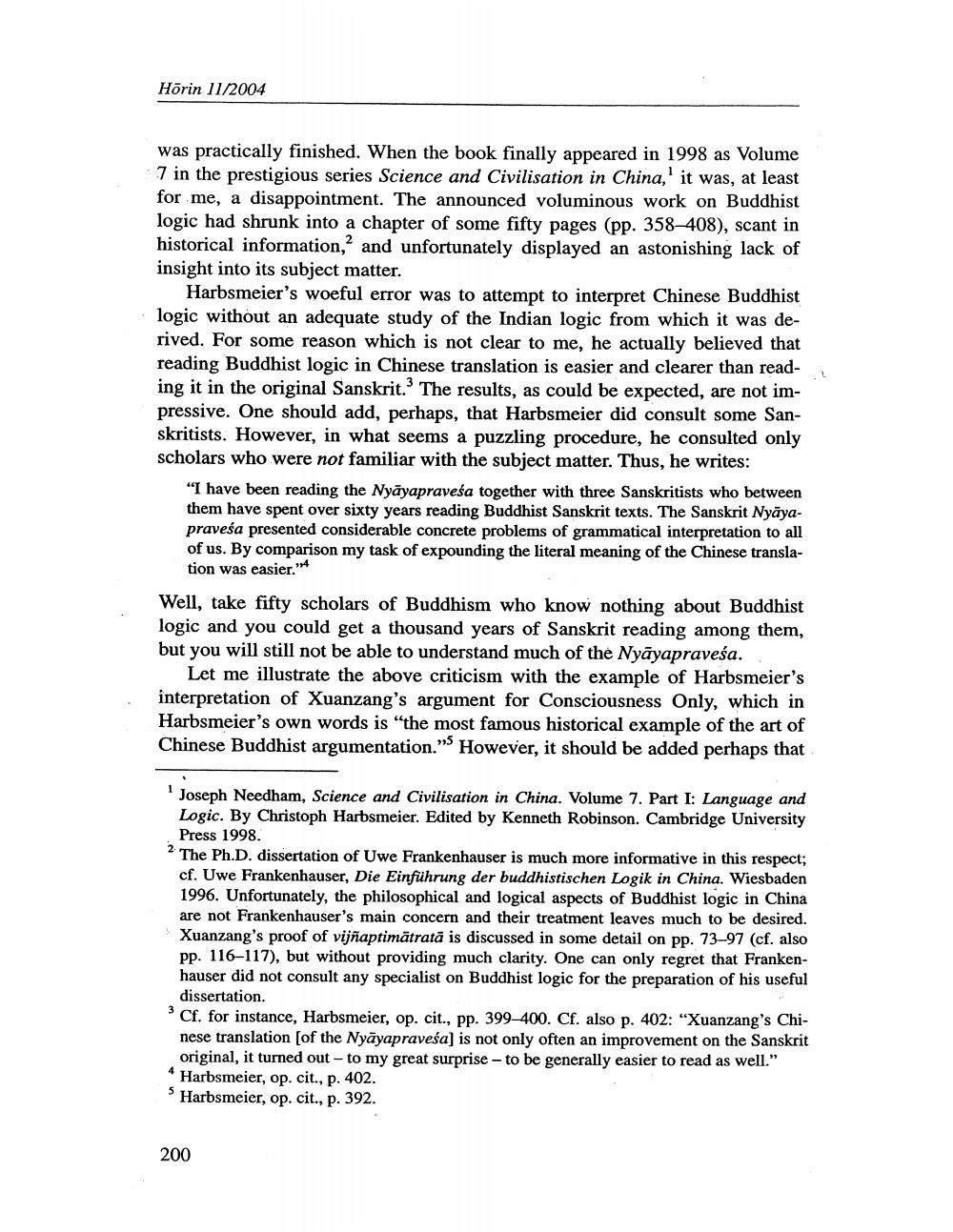________________
Hörin 11/2004
was practically finished. When the book finally appeared in 1998 as Volume 7 in the prestigious series Science and Civilisation in China,' it was, at least for me, a disappointment. The announced voluminous work on Buddhist logic had shrunk into a chapter of some fifty pages (pp. 358-408), scant in historical information, and unfortunately displayed an astonishing lack of insight into its subject matter.
Harbsmeier's woeful error was to attempt to interpret Chinese Buddhist logic without an adequate study of the Indian logic from which it was derived. For some reason which is not clear to me, he actually believed that reading Buddhist logic in Chinese translation is easier and clearer than read-1 ing it in the original Sanskrit." The results, as could be expected, are not impressive. One should add, perhaps, that Harbsmeier did consult some Sanskritists. However, in what seems a puzzling procedure, he consulted only scholars who were not familiar with the subject matter. Thus, he writes:
"I have been reading the Nyāyapraveśa together with three Sanskritists who between them have spent over sixty years reading Buddhist Sanskrit texts. The Sanskrit Nyāyapraveśa presented considerable concrete problems of grammatical interpretation to all of us. By comparison my task of expounding the literal meaning of the Chinese transla
tion was easier." Well, take fifty scholars of Buddhism who know nothing about Buddhist logic and you could get a thousand years of Sanskrit reading among them, but you will still not be able to understand much of the Nyāyapraveśa.
Let me illustrate the above criticism with the example of Harbsmeier's interpretation of Xuanzang's argument for Consciousness Only, which in Harbsmeier's own words is the most famous historical example of the art of Chinese Buddhist argumentation. However, it should be added perhaps that
Joseph Needham, Science and Civilisation in China. Volume 7. Part I: Language and Logic. By Christoph Harbsmeier. Edited by Kenneth Robinson. Cambridge University Press 1998. 2 The Ph.D. dissertation of Uwe Frankenhauser is much more informative in this respect; cf. Uwe Frankenhauser, Die Einführung der buddhistischen Logik in China. Wiesbaden 1996. Unfortunately, the philosophical and logical aspects of Buddhist logic in China are not Frankenhauser's main concern and their treatment leaves much to be desired. Xuanzang's proof of vijnaptimătrată is discussed in some detail on pp. 73-97 (cf. also pp. 116-117), but without providing much clarity. One can only regret that Frankenhauser did not consult any specialist on Buddhist logic for the preparation of his useful dissertation. Cf. for instance, Harbsmeier, op. cit., pp. 399–400. Cf. also p. 402: "Xuanzang's Chinese translation (of the Nyāyapraveśa] is not only often an improvement on the Sanskrit
original, it turned out to my great surprise - to be generally easier to read as well." * Harbsmeier, op. cit., p. 402. Harbsmeier, op. cit., p. 392.
200




